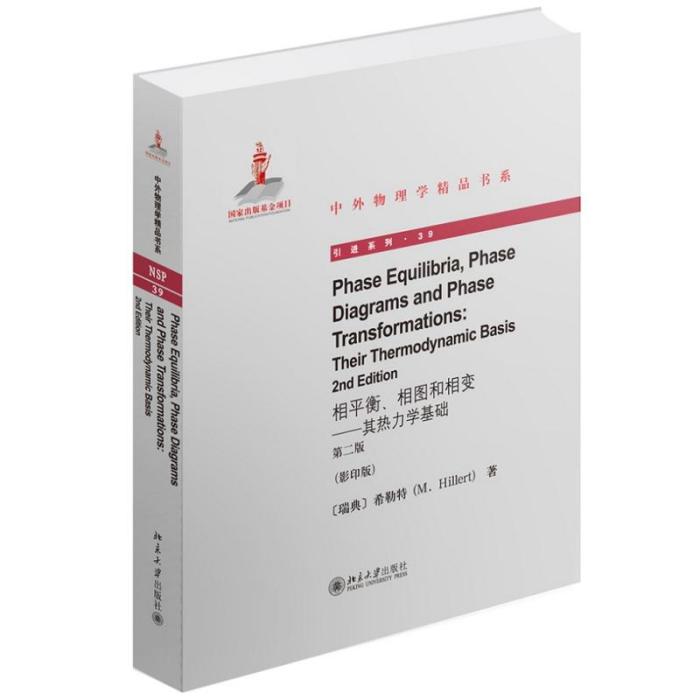《相平衡、相圖和相變——其熱力學基礎(第二版)(英文影印版)》是2014年北京大學出版社出版的圖書,作者是(瑞典)希勒特(M. Hillert)。
基本介紹
- 中文名:相平衡、相圖和相變——其熱力學基礎(第二版)(英文影印版)
- 作者:(瑞典)希勒特(M. Hillert)
- 出版社:北京大學出版社
- 頁數:528 頁
- ISBN:978-7-301-24555-2
- 定價:89 元
- 開本:大32開
- 裝幀:平裝
- 書號:24555
- 字數:629 千字
- 叢書名:中外物理學精品書系
- 版次:1
出版背景,編輯推薦,作者簡介,章節目錄,
出版背景
本書主要內容為現代計算機套用觀點下的熱力學基本原理。 化學平衡和化學變化的理論基礎也是本書的內容之一,其重點在於相圖的性質。本書從基本原理出發,討論延及多相的系統。第二版新增加的內容包括不可逆熱力學、極值原理和表面、界面熱力學等等。 平衡條件的理論刻畫、系統的平衡狀態和達到平衡時的變化都以圖解的形式給出。 本書適合材料科學與工程領域的研究人員、研究生和高年級本科生閱讀。
編輯推薦
《相平衡、相圖和相變——其熱力學基礎(第二版)》是影印版英文專著,原書由劍橋大學出版社於2008年出版。相平衡、相變等熱力學原理是理解、設計材料屬性的基礎。計算工具的出現使材料學家能夠處理越來越複雜的情況,但對於熱力學基礎理論的理解也越來越重要。本書圖文並茂,深入淺出地講解了熱力學原理以及在計算機計算中的套用,對於材料科學、材料工程方面的研究者會有很大幫助。
作者簡介
(瑞典)希勒特(M. Hillert),瑞典皇家工學院教授。
章節目錄
Preface to second edition page xii
Preface to first edition xiii
1 Basic concepts of thermodynamics 1
1.1 External state variables 1
1.2 Internal state variables 3
1.3 The first law of thermodynamics 5
1.4 Freezing-in conditions 9
1.5 Reversible and irreversible processes 10
1.6 Second law of thermodynamics 13
1.7 Condition of internal equilibrium 17
1.8 Driving force 19
1.9 Combined first and second law 21
1.10 General conditions of equilibrium 23
1.11 Characteristic state functions 24
1.12 Entropy 26
2 Manipulation of thermodynamic quantities 30
2.1 Evaluation of one characteristic state function from another 30
2.2 Internal variables at equilibrium 31
2.3 Equations of state 33
2.4 Experimental conditions 34
2.5 Notation for partial derivatives 37
2.6 Use of various derivatives 38
2.7 Comparison between CV and CP 40
2.8 Change of independent variables 41
2.9 Maxwell relations 43
3 Systems with variable composition 45
3.1 Chemical potential 45
3.2 Molar and integral quantities 46
3.3 More about characteristic state functions 48
3.4 Additivity of extensive quantities. Free energy and exergy 51
3.5 Various forms of the combined law 52
3.6 Calculation of equilibrium 54
3.7 Evaluation of the driving force 56
3.8 Driving force for molecular reactions 58
3.9 Evaluation of integrated driving force as function of T or P 59
3.10 Effective driving force 60
4 Practical handling of multicomponent systems 63
4.1 Partial quantities 63
4.2 Relations for partial quantities 65
4.3 Alternative variables for composition 67
4.4 The lever rule 70
4.5 The tie-line rule 71
4.6 Different sets of components 74
4.7 Constitution and constituents 75
4.8 Chemical potentials in a phase with sublattices 77
5 Thermodynamics of processes 80
5.1 Thermodynamic treatment of kinetics of internal processes 80
5.2 Transformation of the set of processes 83
5.3 Alternative methods of transformation 85
5.4 Basic thermodynamic considerations for processes 89
5.5 Homogeneous chemical reactions 92
5.6 Transport processes in discontinuous systems 95
5.7 Transport processes in continuous systems 98
5.8 Substitutional diffusion 101
5.9 Onsager’s extremum principle 104
6 Stability 108 6.1 Introduction 108
6.2 Some necessary conditions of stability 110
6.3 Sufficient conditions of stability 113
6.4 Summary of stability conditions 115
6.5 Limit of stability 116
6.6 Limit of stability against fluctuations in composition 117
6.7 Chemical capacitance 120
6.8 Limit of stability against fluctuations of internal variables 121
6.9 Le Chatelier’s principle 123
7 Applications of molar Gibbs energy diagrams 126
7.1 Molar Gibbs energy diagrams for binary systems 126
7.2 Instability of binary solutions 131
7.3 Illustration of the Gibbs–Duhem relation 132
7.4 Two-phase equilibria in binary systems 135
7.5 Allotropic phase boundaries 137
7.6 Effect of a pressure difference on a two-phase equilibrium 138
7.7 Driving force for the formation of a new phase 142
7.8 Partitionless transformation under local equilibrium 144
7.9 Activation energy for a fluctuation 147
7.10 Ternary systems 149 7.11 Solubility product 151
8 Phase equilibria and potential phase diagrams 155
8.1 Gibbs’ phase rule 155
8.2 Fundamental property diagram 157
8.3 Topology of potential phase diagrams 162
8.4 Potential phase diagrams in binary and multinary systems 166
8.5 Sections of potential phase diagrams 168
8.6 Binary systems 170
8.7 Ternary systems 173
8.8 Direction of phase fields in potential phase diagrams 177
8.9 Extremum in temperature and pressure 181
9 Molar phase diagrams 185
9.1 Molar axes 185
9.2 Sets of conjugate pairs containing molar variables 189
9.3 Phase boundaries 193
9.4 Sections of molar phase diagrams 195
9.5 Schreinemakers’ rule 197
9.6 Topology of sectioned molar diagrams 201
10 Projected and mixed phase diagrams 205
10.1 Schreinemakers’ projection of potential phase diagrams 205
10.2 The phase field rule and projected diagrams 208
10.3 Relation between molar diagrams and Schreinemakers’ projected diagrams 212
10.4 Coincidence of projected surfaces 215
10.5 Projection of higher-order invariant equilibria 217
10.6 The phase field rule and mixed diagrams 220
10.7 Selection of axes in mixed diagrams 223
10.8 Konovalov’s rule 226
10.9 General rule for singular equilibria 229
11 Direction of phase boundaries 233
11.1 Use of distribution coefficient 233
11.2 Calculation of allotropic phase boundaries 235
11.3 Variation of a chemical potential in a two-phase field 238
11.4 Direction of phase boundaries 240
11.5 Congruent melting points 244
11.6 Vertical phase boundaries 248
11.7 Slope of phase boundaries in isothermal sections 249
11.8 The effect of a pressure difference between two phases 251
12 Sharp and gradual phase transformations 253
12.1 Experimental conditions 253
12.2 Characterization of phase transformations 255
12.3 Microstructural character 259
12.4 Phase transformations in alloys 261
12.5 Classification of sharp phase transformations 262
12.6 Applications of Schreinemakers’ projection 266
12.7 Scheil’s reaction diagram 270
12.8 Gradual phase transformations at fixed composition 272
12.9 Phase transformations controlled by a chemical potential 275
13 Transformations in closed systems 279
13.1 The phase field rule at constant composition 279
13.2 Reaction coefficients in sharp transformations for p = c + 1 280
13.3 Graphical evaluation of reaction coefficients 283
13.4 Reaction coefficients in gradual transformations for p = c 285
13.5 Driving force for sharp phase transformations 287
13.6 Driving force under constant chemical potential 291
13.7 Reaction coefficients at constant chemical potential 294
13.8 Compositional degeneracies for p = c 295
13.9 Effect of two compositional degeneracies for p = c . 1 299
14 Partitionless transformations 302
14.1 Deviation from local equilibrium 302
14.2 Adiabatic phase transformation 303
14.3 Quasi-adiabatic phase transformation 305
14.4 Partitionless transformations in binary system 308
14.5 Partial chemical equilibrium 311
14.6 Transformations in steel under quasi-paraequilibrium 315
14.7 Transformations in steel under partitioning of alloying elements 319
15 Limit of stability and critical phenomena 322
15.1 Transformations and transitions 322
15.2 Order–disorder transitions 325
15.3 Miscibility gaps 330
15.4 Spinodal decomposition 334

